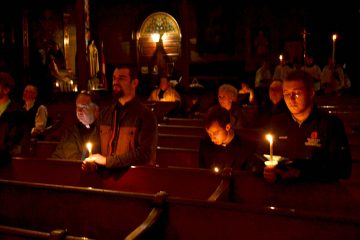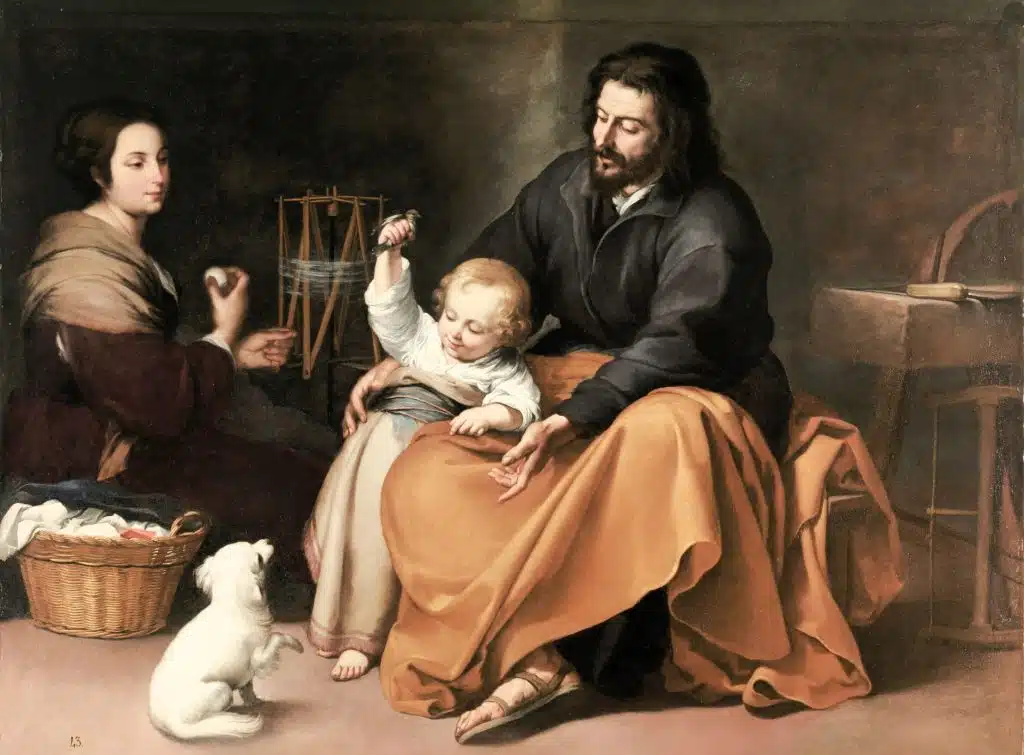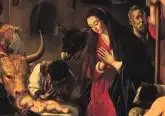Quiet Joy

In a visually saturated world, it’s easy to feel overwhelmed and become desensitized to beauty. Visio Divina, Latin for “divine seeing,” encourages us to slow down and engage in visual contemplation, using art as a profound tool for connecting with the Divine.
A Guide to Visio Divina
Begin by making the sign of the cross and inviting the Holy Spirit to guide your contemplation. Spend a moment meditating on The Holy Family with a Little Bird, ca. 1650, by Bartolomé Esteban Murillo, located in the Prado Museum, Madrid. Then, read Matthew 18:1-5.
Background
Murillo grew up in Seville, Spain, as the youngest of 14 siblings. Orphaned at a young age, his older sister raised him. In 1645, Murillo married and eventually became the father of nine children. Surrounded by family throughout his life, he was known for his warm, kind- hearted nature and admiration for home life—qualities that shine through much of his work.
As an adult, he lived a fairly comfortable and successful life. His career flourished with steady commissions, and his reputation grew as both an accomplished painter and a delightful person.
During the mid- to late-17th century, the Spanish Baroque style began to evolve. Artists shifted away from grand, dramatic subjects and adopted a more sentimental approach—one that emphasized family, tenderness, and the quiet mysticism found in everyday life. Murillo mastered this trend. His religious scenes, often grounded in the familiar rhythms of family life, reflected a holiness that was gentle, accessible, and deeply human.
Enter In
Taking a break from his carpentry work, Joseph sits down to enjoy a moment with his family. Small and curious, Jesus leans against His earthly father while playfully clutching a little bird and engaging with a dog at His feet. Joseph, with a quiet smile and watchful eyes, keeps his arms near Jesus’ sides—ready to catch Him if He stumbles. The dog whines and begs to play with the bird. You can almost hear the soft sound of baby giggles.
Beside father and Son, Mary watches lovingly as she spins yarn. A basket of clothing or fabric rests at her feet. She pauses from her housework for a moment, softly smiling at Jesus and Joseph. Her gaze is calm and reflective—perhaps, full of gratitude.
Murillo’s painting is quite charming, isn’t it? It’s not often we see the Holy Family participating in such an ordinary, domestic scene—amongst housework, play, and quiet smiles. With the use of naturalism, contemporary clothing, humble surroundings, and the absence of haloes, Murillo grounds the Holy Family in the familiar, making them approachable and human.
What I find most interesting about this scene is seeing little Jesus playing with His pets. But why a bird and a dog? Since the Ancient Greeks, dogs in art have symbolized loyalty, fidelity, and the home—an ideal protector and companion. Birds have carried spiritual significance across cultures. In Ancient Egypt, Ba—a human-headed bird—represented the soul, often depicted hovering above a mummy to symbolize its journey to the afterlife.
In Judeo-Christian art, small birds—particularly robins and goldfinches—came to symbolize Christ’s Passion. According to legend, a small bird plucked a thorn from Christ’s crown, causing blood to shoot out. This story gave rise to a belief about why robins and goldfinches bear their red markings. As The Fitzwilliam Museum at Cambridge notes, “A very general reading of the goldfinch might, therefore, remind the viewer that his soul is ‘in the hands of God.’”
Reflection
At first glance, this painting of the Holy Family seems quiet and ordinary. Murillo depicts this moment of play and normalcy to remind us that Jesus was also a child.
Eternally divine, God assumed a human nature through the Incarnation, becoming fully God and fully man in the personhood of Jesus Christ. In doing so, He entered not just our world, but human experience as we know it. As theologian Frank Sheed writes in To Know Christ Jesus:
“Like the rest of us, He was born a baby, grew into a small boy, a big boy, a youth, a man. Human bodies … [and] human souls have laws … and [He] was subject to them. He had five senses, and they really worked. The outer world came through to His brain as He saw it … His human mind took hold of what the senses had brought to the brain and acted upon it, reacted to it, [and] went through all the processes of human thinking upon it” (72).
Jesus did not use His divinity to create an easy life for Himself, as Sheed exclaims, “He did not take shortcuts!”
(72). He entered the world through the pain of childbirth, screaming and gasping for air, experiencing hunger, and needing to be breastfed. Though He was God, Jesus had to depend on His parents for nourishment, for guidance, to learn how to talk and walk, and to grow in understanding—not only as a child, but throughout His life.
In turn, Mary and Joseph certainly experienced a wholly unique form of parenthood. They were entrusted with raising not just any child, but a child who was God. There was no precedent for this—they couldn’t turn to other parents for advice on how to raise the Messiah. Mary and Joseph had to gradually learn “bit by bit—from the things that happened, like everyone else—who and what the Redeemer was” (73-74).
This dependency—Jesus relying on His parents, and His parents relying on God—is what Jesus points to when He says, “Unless you turn and become like children, you will not enter the Kingdom of Heaven” (Mt. 18:3). In light of this, we are called to cultivate the same childlike dependency on God.
As the Jerome Biblical Commentary explains, becoming like a child is not only a great virtue, it is necessary for entry into the Kingdom. This means recognizing that we cannot do everything on our own—that we are, after all, only human. But that is not a flaw; it is an invitation.
There is much we can learn from children. Like a child, Jesus wants us to approach life not with self-reliance but with utter dependence on God; not with ignorance but with innocence; not with apathy but with wonder. And when we begin to see and depend like a child, we open ourselves to a kind of quiet joy, like the one captured in Murillo’s painting.
Joy is distinct from happiness. While happiness is a fleeting emotion dependent on circumstance, joy arises from an encounter with what is true, good, and beautiful. It lingers. It deepens. It has the ability to blossom into something greater—something that forms us, rather than simply delights us. In fact, joy may not always feel delightful because it’s more than a passing emotion.
Murillo paints joy here, but it isn’t loud. It doesn’t demand attention. It simply just is. And there is beauty in that— beauty in the simplicity, the mundane, and even the quiet, small moments.
 Emma Cassani [email protected] is the graphic designer behind The Catholic Telegraph. She is passionate about exploring the intersection between art and faith.
Emma Cassani [email protected] is the graphic designer behind The Catholic Telegraph. She is passionate about exploring the intersection between art and faith.
This article appeared in the July 2025 edition of The Catholic Telegraph Magazine. For your complimentary subscription, click here.















